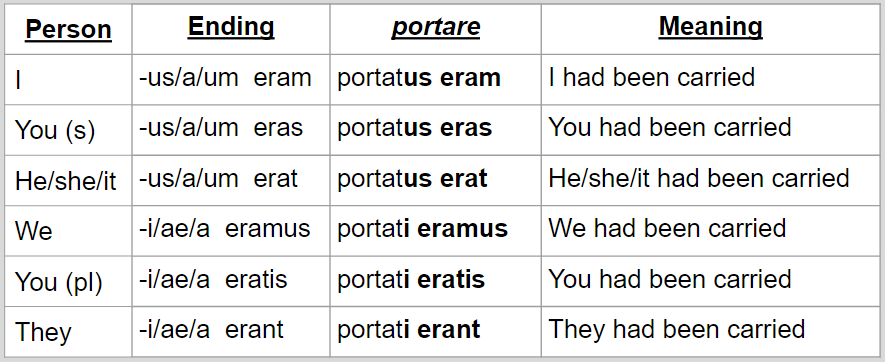Pluperfect Passives: Still More Than Perfect
January Latin Challenge: Day 30 of 31
Just two days left of the January Latin Challenge on bambasbat! Don’t worry though, there is plenty more planned for after this 31 Day Challenge.
Today we are looking at pluperfect passive verbs, how to form them, how to recognize them, and how to translate them from the Latin into English.
If you're not sure about any of the verb endings from this video or any of the previous ones, go and download my Complete Reference Guide to Latin Verbs. It'll really help you out, just be handy to have nearby while you go through these exercises.
Active or Passive?
An active verb is where the nominative is doing the verb.
The boy had kicked the horse.
He did it, it was him.
A passive verb is when the nominative is having the verb done to it.
The boy had been kicked by the horse.
The boy is still nominative, but his role in the sentence has changed. He is no longer actively doing the verb. He is now passively receiving the verb, but he's still grammatically nominative.
Pluperfect passives in Latin
They're formed from the perfect passive participle, which is the fourth principle part in your dictionary lists. They use the imperfect tense of the verb “to be”, esse.
Now, the perfect passive participle is always nominative when using it for pluperfect passive verbs, but it changes gender and number to match the person that is the passive nominative of the verb.
Let me show you what I mean in this table:
So the endings for the first, second, and third person singular are the nominative form for the masculine, feminine, and neuter options.
Singular
For the first 3 options, the singular person endings, I've got -us, -a, -um.
-us for a masculine nominative
-a for a feminine nominative
-um for a neuter nominative
If the nominative is the 1st person singular, then I use the imperfect eram. If the nominative is the 2nd singular, then it's eras. For 3rd singular, it's erat. This is my imperfect tense of the verb to be.
Plural
When I get to the plural person ending, the nominative ending changes to match the number of the nominative that it is describing.
-i for masculine plural
-ae for feminine plural
-a for neuter plural
Then I add on the imperfect tense, eramus, eratis, erant. They are two different words, so try not to get too confused between just esse on its own and esse attached to a participle.
Be really careful to translate the pluperfect as HAD and not HAVE or HAS because that would make it perfect, not pluperfect, and you want to show that you know the difference.
Example Sentences
Here are 3 sentences. The vocabulary is in the green box below. For the verbs, you'll see they're longer than usual: that's because I've given you all four parts of the verb. This is how you'll usually see verbs in your dictionary. If you have forgotten what the four parts of the verb mean, here is Day 20: The Importance of Principal Parts.
The fourth principle parts are the ones I'm focusing on today. They're the ones we're going to be looking for, added to the verb “to be” to make our pluperfect passive verbs.
Have a go, and then read on when you are ready for the answers.
a senatoribus salutatae eramus.
cur puniti erant, pater?
bellum a militibus pugnatum erat.
Read on when ready
a senatoribus salutatae eramus.
a senatoribus means “by the senators”, but doesn't have anything to do with my verb, so I'm going to move on.
eramus tells me that it is a 1st person plural of a verb, and I'm going to be looking for a plural perfect passive participle. I have one: salutatae.
Now I know that the nominative is feminine, a group of feminine nouns because my -ae ending can only be nominative, plural, feminine.
“So we had been greeted by the senators.”
cur puniti erant, pater?
This is a question, so I might need to change around how I order my translation.
The question is addressed to pater, “father”.
Start with the verb still, puniti erant. A third person plural version of the verb “to be” in the imperfect, erant. Then check in front of it, see if there is a perfect passive participle. Yes, puniti comes from punitus. It is a plural masculine normative. “They had been punished”.
Because it's a question, I'm going to use cur, “why?” and I'm going to switch around my translation.
So rather than saying they had been punished, I'm going to say, “why had they been punished, father?”
bellum a militibus pugnatum erat.
pugnatum erat is a neuter third person singular, pluperfect passive. It comes from the verb pugno. It is the fourth principle part, pugnatus, and it changes it into a neuter singular: pugnatum. “It had been fought”.
bellum matches my ending - it's a neuter singular nominative.
a militibus, a bit more information, “by the soldiers”.
“The war had been fought by the soldiers.”
So that's all you really need to know about pluperfect passives. You use the perfect passive participle, the fourth principle part in your dictionary, and you add to it esse in the imperfect tense, the verb “to be”.
The main thing you need to remember is that the perfect passive participle ending changes based on gender and number. The good thing is it's always going to be nominative, because the nominative has to link with the verb. It has to match.
I hope that's been helpful. If you have any questions, let me know in the comments. Otherwise, thank you so much for joining me today, and I'll see you tomorrow on bambasbat for the FINAL DAY of the January Latin Challenge!



